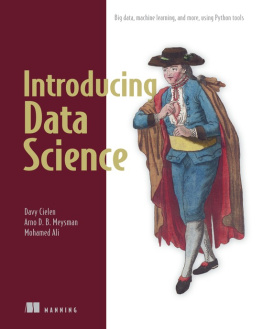Frank Kane [Frank Kane] - Hands-On Data Science and Python Machine Learning
Here you can read online Frank Kane [Frank Kane] - Hands-On Data Science and Python Machine Learning full text of the book (entire story) in english for free. Download pdf and epub, get meaning, cover and reviews about this ebook. year: 2017, publisher: Packt Publishing, genre: Business. Description of the work, (preface) as well as reviews are available. Best literature library LitArk.com created for fans of good reading and offers a wide selection of genres:
Romance novel
Science fiction
Adventure
Detective
Science
History
Home and family
Prose
Art
Politics
Computer
Non-fiction
Religion
Business
Children
Humor
Choose a favorite category and find really read worthwhile books. Enjoy immersion in the world of imagination, feel the emotions of the characters or learn something new for yourself, make an fascinating discovery.
- Book:Hands-On Data Science and Python Machine Learning
- Author:
- Publisher:Packt Publishing
- Genre:
- Year:2017
- Rating:4 / 5
- Favourites:Add to favourites
- Your mark:
Hands-On Data Science and Python Machine Learning: summary, description and annotation
We offer to read an annotation, description, summary or preface (depends on what the author of the book "Hands-On Data Science and Python Machine Learning" wrote himself). If you haven't found the necessary information about the book — write in the comments, we will try to find it.
This book covers the fundamentals of machine learning with Python in a concise and dynamic manner. It covers data mining and large-scale machine learning using Apache Spark.
About This Book
- Take your first steps in the world of data science by understanding the tools and techniques of data analysis
- Train efficient Machine Learning models in Python using the supervised and unsupervised learning methods
- Learn how to use Apache Spark for processing Big Data efficiently
Who This Book Is For
If you are a budding data scientist or a data analyst who wants to analyze and gain actionable insights from data using Python, this book is for you. Programmers with some experience in Python who want to enter the lucrative world of Data Science will also find this book to be very useful, but you dont need to be an expert Python coder or mathematician to get the most from this book.
What You Will Learn
- Learn how to clean your data and ready it for analysis
- Implement the popular clustering and regression methods in Python
- Train efficient machine learning models using decision trees and random forests
- Visualize the results of your analysis using Pythons Matplotlib library
- Use Apache Sparks MLlib package to perform machine learning on large datasets
In Detail
Join Frank Kane, who worked on Amazon and IMDbs machine learning algorithms, as he guides you on your first steps into the world of data science. Hands-On Data Science and Python Machine Learning gives you the tools that you need to understand and explore the core topics in the field, and the confidence and practice to build and analyze your own machine learning models. With the help of interesting and easy-to-follow practical examples, Frank Kane explains potentially complex topics such as Bayesian methods and K-means clustering in a way that anybody can understand them.
Based on Franks successful data science course, Hands-On Data Science and Python Machine Learning empowers you to conduct data analysis and perform efficient machine learning using Python. Let Frank help you unearth the value in your data using the various data mining and data analysis techniques available in Python, and to develop efficient predictive models to predict future results. You will also learn how to perform large-scale machine learning on Big Data using Apache Spark. The book covers preparing your data for analysis, training machine learning models, and visualizing the final data analysis.
Style and approach
This comprehensive book is a perfect blend of theory and hands-on code examples in Python which can be used for your reference at any time.
Downloading the example code for this book. You can download the example code files for all Packt books you have purchased from your account at http://www.PacktPub.com. If you purchased this book elsewhere, you can visit http://www.PacktPub.com/support and register to have the code file.
Frank Kane [Frank Kane]: author's other books
Who wrote Hands-On Data Science and Python Machine Learning? Find out the surname, the name of the author of the book and a list of all author's works by series.

![Frank Kane [Frank Kane] Hands-On Data Science and Python Machine Learning](/uploads/posts/book/119615/thumbs/frank-kane-frank-kane-hands-on-data-science-and.jpg)









